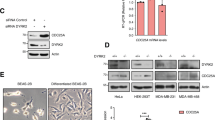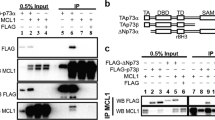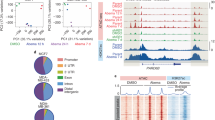Abstract
Cdc25B phosphatases have a key role in G2/M cell-cycle progression by activating the CDK1-cyclinB1 complexes and functioning as important targets of checkpoints. Overexpression of Cdc25B results in a bypass of the G2/M checkpoint and illegitimate entry into mitosis. It can also cause replicative stress, which leads to genomic instability. Thus, fine-tuning of the Cdc25B expression level is critical for correct cell-cycle arrest in response to DNA damage. In response to genotoxic stress, Cdc25B is mainly regulated by post-transcriptional mechanisms affecting either Cdc25B protein stability or translation. Here, we show that upon DNA damage Cdc25B can be regulated at the transcriptional level. Although ionizing radiation downregulates Cdc25B in a p53-dependent pathway, doxorubicin transcriptionally upregulates Cdc25B in p53-proficient cancer cells. We show that in the presence of wild-type p53, doxorubicin activates the Cdc25B promoter by preventing the binding of Sp1 and increasing the binding of NF-Y on the Cdc25B promoter, thus preventing p53 from downregulating this promoter. Our results highlight the mechanistically distinct regulation of the three Cdc25 phosphatases by checkpoint signalling following doxorubicin treatment.
This is a preview of subscription content, access via your institution
Access options
Subscribe to this journal
Receive 50 print issues and online access
$259.00 per year
only $5.18 per issue
Buy this article
- Purchase on Springer Link
- Instant access to full article PDF
Prices may be subject to local taxes which are calculated during checkout




Similar content being viewed by others
References
Boutros R, Dozier C, Ducommun B . The when and wheres of CDC25 phosphatases. Curr Opin Cell Biol 2006; 18: 185–191.
Lindqvist A, Kallstrom H, Lundgren A, Barsoum E, Rosenthal CK . Cdc25B cooperates with Cdc25A to induce mitosis but has a unique role in activating cyclin B1-Cdk1 at the centrosome. J Cell Biol 2005; 171: 35–45.
Galaktionov K, Lee AK, Eckstein J, Draetta G, Meckler J, Loda M et al. CDC25 phosphatases as potential human oncogenes. Science 1995; 269: 1575–1577.
Kang CM, Cho HN, Ahn JM, Lee SS, Jeoung DI, Cho CK et al. Alteration of gene expression during radiation-induced resistance and tumorigenesis in NIH3T3 cells revealed by cDNA microarrays: involvement of MDM2 and CDC25B. Carcinogenesis 2004; 25: 123–132.
Yao Y, Slosberg ED, Wang L, Hibshoosh H, Zhang YJ, Xing WQ et al. Increased susceptibility to carcinogen-induced mammary tumors in MMTV-Cdc25B transgenic mice. Oncogene 1999; 18: 5159–5166.
Boutros R, Lobjois V, Ducommun B . CDC25 phosphatases in cancer cells: key players? Good targets? Nat Rev Cancer 2007; 7: 495–507.
Karlsson-Rosenthal C, Millar JB . Cdc25: mechanisms of checkpoint inhibition and recovery. Trends Cell Biol 2006; 16: 285–292.
Aressy B, Bugler B, Valette A, Biard D, Ducommun B . Moderate variations in CDC25B protein levels modulate the response to DNA damaging agents. Cell Cycle 2008; 7: 2234–2240.
Bugler B, Quaranta M, Aressy B, Brezak MC, Prevost G, Ducommun B . Genotoxic-activated G2-M checkpoint exit is dependent on CDC25B phosphatase expression. Mol Cancer Ther 2006; 5: 1446–1451.
Miyata H, Doki Y, Yamamoto H, Kishi K, Takemoto H, Fujiwara Y et al. Overexpression of CDC25B overrides radiation-induced G2-M arrest and results in increased apoptosis in esophageal cancer cells. Cancer Res 2001; 61: 3188–3193.
Bansal P, Lazo JS . Induction of Cdc25B regulates cell cycle resumption after genotoxic stress. Cancer Res 2007; 67: 3356–3363.
Jullien D, Bugler B, Dozier C, Cazales M, Ducommun B . Identification of N-terminally truncated stable nuclear isoforms of CDC25B that are specifically involved in G2/M checkpoint recovery. Cancer Res 2011; 71: 1968–1977.
Lemaire M, Froment C, Boutros R, Mondesert O, Nebreda AR, Monsarrat B et al. CDC25B phosphorylation by p38 and MK-2. Cell Cycle 2006; 5: 1649–1653.
Dalvai M, Mondesert O, Bourdon JC, Ducommun B, Dozier C . Cdc25B is negatively regulated by p53 through Sp1 and NF-Y transcription factors. Oncogene 2011; 30: 2282–2288.
Korner K, Jerome V, Schmidt T, Muller R . Cell cycle regulation of the murine cdc25B promoter: essential role for nuclear factor-Y and a proximal repressor element. J Biol Chem 2001; 276: 9662–9669.
Scian MJ, Carchman EH, Mohanraj L, Stagliano KE, Anderson MA, Deb D et al. Wild-type p53 and p73 negatively regulate expression of proliferation related genes. Oncogene 2008; 27: 2583–2593.
Zhao H, Watkins JL, Piwnica-Worms H . Disruption of the checkpoint kinase 1/cell division cycle 25A pathway abrogates ionizing radiation-induced S and G2 checkpoints. Proc Natl Acad Sci USA 2002; 99: 14795–14800.
Wang B, Xiao Z, Ko HL, Ren EC . The p53 response element and transcriptional repression. Cell Cycle 2010; 9: 870–879.
Rashi-Elkeles S, Elkon R, Shavit S, Lerenthal Y, Linhart C, Kupershtein A et al. Transcriptional modulation induced by ionizing radiation: p53 remains a central player. Mol Oncol 2011; 5: 336–348.
St Clair S, Giono L, Varmeh-Ziaie S, Resnick-Silverman L, Liu WJ, Padi A et al. DNA damage-induced downregulation of Cdc25C is mediated by p53 via two independent mechanisms: one involves direct binding to the cdc25C promoter. Mol Cell 2004; 16: 725–736.
Xiao Z, Chen Z, Gunasekera AH, Sowin TJ, Rosenberg SH, Fesik S et al. Chk1 mediates S and G2 arrests through Cdc25A degradation in response to DNA-damaging agents. J Biol Chem 2003; 278: 21767–21773.
Baldin V, Cans C, Knibiehler M, Ducommun B . Phosphorylation of human CDC25B phosphatase by CDK1-cyclin A triggers its proteasome-dependent degradation. J Biol Chem 1997; 272: 32731–32734.
Bu Y, Suenaga Y, Ono S, Koda T, Song F, Nakagawara A et al. Sp1-mediated transcriptional regulation of NFBD1/MDC1 plays a critical role in DNA damage response pathway. Genes Cells 2008; 13: 53–66.
Uchida Y, Itoh M, Taguchi Y, Yamaoka S, Umehara H, Ichikawa S et al. Ceramide reduction and transcriptional up-regulation of glucosylceramide synthase through doxorubicin-activated Sp1 in drug-resistant HL-60/ADR cells. Cancer Res 2004; 64: 6271–6279.
Xu J, Zhou JY, Wei WZ, Philipsen S, Wu GS . Sp1-mediated TRAIL induction in chemosensitization. Cancer Res 2008; 68: 6718–6726.
Chu S . Transcriptional regulation by post-transcriptional modification-Role of phosphorylation in Sp1 transcriptional activity. Gene 508: 1–8.
Beishline K, Kelly CM, Olofsson BA, Koduri S, Emrich J, Greenberg RA et al. Sp1 facilitates DNA double-strand break repair through a nontranscriptional mechanism. Mol Cell Biol 2012; 32: 3790–3799.
Iwahori S, Yasui Y, Kudoh A, Sato Y, Nakayama S, Murata T et al. Identification of phosphorylation sites on transcription factor Sp1 in response to DNA damage and its accumulation at damaged sites. Cell Signal 2008; 20: 1795–1803.
Olofsson BA, Kelly CM, Kim J, Hornsby SM, Azizkhan-Clifford J . Phosphorylation of Sp1 in response to DNA damage by ataxia telangiectasia-mutated kinase. Mol Cancer Res 2007; 5: 1319–1330.
Bocangel D, Sengupta S, Mitra S, Bhakat KK . p53-Mediated down-regulation of the human DNA repair gene O6-methylguanine-DNA methyltransferase (MGMT) via interaction with Sp1 transcription factor. Anticancer Res 2009; 29: 3741–3750.
Cuesta A, Zambrano A, Royo M, Pascual A . The tumour suppressor p53 regulates the expression of amyloid precursor protein (APP). Biochem J 2009; 418: 643–650.
Thompson T, Tovar C, Yang H, Carvajal D, Vu BT, Xu Q et al. Phosphorylation of p53 on key serines is dispensable for transcriptional activation and apoptosis. J Biol Chem 2004; 279: 53015–53022.
Szulawska A, Gniazdowski M, Czyz M . Sequence specificity of formaldehyde-mediated covalent binding of anthracycline derivatives to DNA. Biochem Pharmacol 2005; 69: 7–18.
Acknowledgements
The authors thank Dr Bert Vogelstein (Howard Hughes Medical Institute, Baltimore USA) for providing the WT and p53−/− HCT116 cells. MD was a recipient of a post-doctoral fellowship from Fondation de la Recherche Medicale. This work was supported by C.N.R.S, Université Paul Sabatier, la région Midi-Pyrénées, l’Institut National du Cancer (PL2008), the Cancéropôle Grand Sud-Ouest, le conseil de radioprotection d’EDF et la Ligue Nationale Contre le Cancer (Equipe labellisée 2008).
Author information
Authors and Affiliations
Corresponding author
Ethics declarations
Competing interests
The authors declare no conflict of interest.
Additional information
Supplementary Information accompanies the paper on the Oncogene website
Rights and permissions
About this article
Cite this article
Dalvai, M., Mondesert, O., Bugler, B. et al. Doxorubicin promotes transcriptional upregulation of Cdc25B in cancer cells by releasing Sp1 from the promoter. Oncogene 32, 5123–5128 (2013). https://doi.org/10.1038/onc.2012.524
Received:
Revised:
Accepted:
Published:
Issue Date:
DOI: https://doi.org/10.1038/onc.2012.524
Keywords
This article is cited by
-
An increase in long non-coding RNA PANDAR is associated with poor prognosis in clear cell renal cell carcinoma
BMC Cancer (2017)
-
Low expression of long noncoding RNA PANDAR predicts a poor prognosis of non-small cell lung cancer and affects cell apoptosis by regulating Bcl-2
Cell Death & Disease (2015)
-
MicroRNA-211, a direct negative regulator of CDC25B expression, inhibits triple-negative breast cancer cells’ growth and migration
Tumor Biology (2015)



